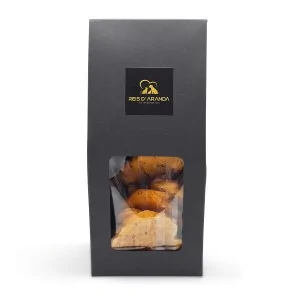The Tornjak originated from genetically homogeneous, almost extinct, indigenous shepherd dogs. These dogs have...
THE MERLE GENE
THE MERLE GENE
The Merle gene is actually called PMEL, this gene codes for a glycoprotein, which is basically the precursor of the substrate for the deposition of melanin (cellular pigment that expresses colour in skin, hair and eyes). It is a recessive gene that requires two carrier dogs to arise, but this is not as easy as it sounds as it is a gene that has to be handled very carefully.
When this gene is present in a dog with normal colouring, the genotype is m/m (recessive), and the colour coat is normal (non-merle); when the dog is a healthy Merle, its genotype is M/m (it has only one copy of the gene), in this case the glycoproteins have modifications that produce the dilution of colouring at random, as we have already explained; However, when it is a ‘double merle’ dog (M/M) these glycoproteins are almost totally damaged, so that there is no way to fix melanin and therefore no coat colour, moreover, as these proteins are involved in the embryonic development of the inner ear and the pigmentation of the retina, this dog will usually be a completely white individual, with severe physical, ocular and auditory damage; ‘double merle’ dogs have two copies of the merle gene.
A healthy merle dog (possessing only one copy of the gene), has attractive black/grey/white colouring in an irregular and whimsical pattern (not fixed spots), the eyes may be blue, brown, heterochromatic (one blue and one brown) or ‘split’ (brown spotted with blue, but not completely one colour).
DOG BREEDS THAT NATURALLY CARRY THE MERLE GENE
Within the canine world there are several breeds which naturally carry the merle gene.
-BORDER COLLIE
-SHETLAND SHEPHERD
-AUSTRALIAN SHEPHERD
-SMOOTH COLLIE
-ROUGH COLLIE
-AMERICAN MINIATURE SHEPHERD
-TECKEL
-POMERANIA
-CHIHUAHUAHUA
-WELSH CORGI CARDIGAN
-BOBTAIL
-AMERICAN COCKER
-GREAT DANISH
-PIT BULL
-AMERICAN STAFFORDSHIRE TERRIER
OTHER ANIMALS CARRYING THE MERLE GENE
Guinea pigs, for example, can have the merle gene, hence their breeding (as with all animals) must be done in a very responsible way, the breeder must be properly trained, be guided by other more experienced breeders, consult the club to which he belongs etc, otherwise we can find ourselves with ‘double merles’ or ‘white syndromes’ (which we will talk about later).
THE MERLE GENE TODAY
The merle gene is very popular (very popular!) and several ‘breeders’ both in Spain and abroad take advantage of this to sell mongrels or animals with a small percentage of mongrel blood at exorbitant prices, when their genetic or morphological quality is very doubtful. Likewise, many take advantage of the ignorance of some people to sell them double merles; all this is labelled as ‘exotic colour’. This can occur in Yorkshire terriers, English bulldogs or French bulldogs, for example, as well as in different poodle mongrels (doodles).
THE DOUBLE MERLE
The M gene has two alleles, the M (merle) and the m (normal, non-merle) and as with all genes, organisms will carry two alleles (which can be the same or different) of this gene, one inherited from the father and the other from the mother, which means that there can be 3 different genotypes for this gene, which in this case will also give 3 different phenotypes: the normal (mm), the merle (Mm) and the double merle (MM).
Thus, in a cross between two solid coloured dogs all puppies will be solid coloured. It is not possible for any of them to be merle coloured, unless one of the parents is what is called ‘phantom merle’ which can occur in cases of eered or sable.
If a solid coloured dog is crossed with a merle coloured dog, approximately half of the puppies will be solid coloured and half will be merle coloured.
But if the cross is merle with merle, the famous ‘double merle’ will occur, with all the problems that entails:
- DEAFNESS: Many puppies are born deaf (or with limited hearing) because for the inner ear cells to function properly, these cells must contain pigment. In the double merle, a defect similar to that of dogs with excessive white (the absence of pigment is common to both cases) causes these inner ear cells to simply not perform their function. The external white coat colour of the ears is not necessarily indicative of what is happening in the inner ear.
- EYE PROBLEMS: Some are mild (small defects in the shape of the pupil) or severe (pupil with important deformities, inability to adapt to light, lens luxation, loss of part of the iris), and even microphthalmia (one or both eyes smaller, or even non-existent). These cases should be evaluated by a veterinary ophthalmologist, there are dogs that are born limited and the disease does not evolve or evolves slowly, while others will be blind in a short time.
- WHITE PUPPY DISEASE: The ‘double merle’ (M/M) is lethal, and many puppies die at or shortly after birth.
- INFERTILITY
When we have a merle puppy we have to cross it with a solid dog that does not carry this gene, either because there are no merle dogs in its bloodline or because it has not inherited it from the sire or dam, for this a test is done in the laboratory before the crossing.
CONCLUSION
The merle gene is fascinating and merle dogs are an absolute beauty, but it is a gene that must be respected and studied a lot before breeding (not as a pet, but for selection purposes). The ‘double merle’ is the result of irresponsibility and ignorance.
Leave a comment
Log in to post comments
Comments
Buenos perros
By: Vicente On 05/11/2024Los pastores australianos son muy buenos perros, yo me dedico al agility y son geniales, mucho más estables que los border
Muy interesante
By: Vida On 05/11/2024No sabía nada de este gen, me ha gustado mucho el artículo
Kiero uno
By: Christal On 05/11/2024Me encantaría tener un border merle
Super chiens
By: Thomas On 05/11/2024J'ai eu des collies merle toute ma vie, le dernier que j'ai adopté d'un refuge et le frère était un double merle, il était très triste, il est mort d'une infection.
Yo tengo uno
By: Christina On 05/11/2024Yo tengo un chihuahua merle y está medo loco, no sé si es por su raza o porque todos los merle son así xDDD no conozco más en mi ciudad, estaría chuli hacer una quedada
My favorite gene
By: Kenneth On 05/11/2024It's my favorite gene, especially red.
Muy curioso
By: Mercedes On 05/11/2024Son unos perros preciosos, el mundo del perro es fascinante y se ve que hay que estudiar mucho para hacer las cosas bien.
Sorprendente
By: Roberto On 05/11/2024Wao, no sabía que este gen pudiera dar problemas, yo tengo un lassie mirlo y quería conseguirle una novia del mismo color, voy a investigar más porque no quiero cachorros enfermos
Super good article
By: Nely On 05/11/2024Very good article, simple and clear but well informed. I really liked the part about the breeds because I only knew the merle in the border collie and the aussie.
A very important article
By: Steve Kenneth On 05/11/2024This is very important to know, especially when someone wants to start breeding. An article about the Mdr1 would be interesting
















